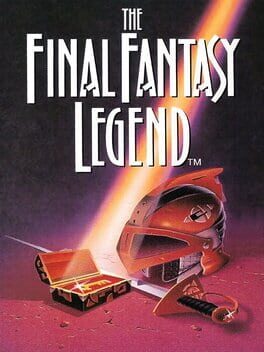The medium in which games are experienced should dictate how they're made. What you want out of a game when you're willing to spend two hours on the couch is different than the sort of game you'd want to play for 15-30 min on a lunch break. SaGa 1 (which I'll be referring to the game as from this point on) succeeds because, in a time before handheld game design had a standard to follow at all, the staff that worked on this game understood their assignment. They got with the program.
This is a game you can spend half a hour in and make significant progress, while not compromising on the sort of experience you could expect from a JRPG around this time. The pacing is excellent. The overworld(s) that you visit are large enough to create interesting exploration, but small enough to where even if you're totally lost, you can reliably exhaust every nook and cranny the game will let you in and probably get on the right track. Fights are quick and reward enough XP to where grinding sessions, if they need to happen, wouldn't last more than a single bus trip. The story is sparse, but there's enough worldbuilding to make the journey engaging.
All of that said, the game is still the first SaGa game. The franchise has been willing to experiment with JRPG mechanics through most of their entries, and this game manages to balance experimentation and accessibility. The different party combinations allow for replayability that goes beyond what Final Fantasy 1 offered, but there aren't a ton of wrong choices. The monster transformation system of eating meat rewards players who are willing to break the system over their knee, but the way that meat is tiered doesn't punish players for rolling the dice blindly. As long as you're progressing the plot, you'll be given what you need to clear the game. This game has permadeath that matters, but if you're willing to spend the time to gather enough cash, you can buy your way out of having to actually worry about it. None of the fights take more than that sweet fifteen minutes mark, but still require the player to optimize their party to the best of their ability.
It's such a unique RPG, especially for the time it was released, but it also makes total sense as to why this was the second "Final Fantasy" game that Square brought over. For years, the only real competition this game had on the Gameboy were the other SaGa games, and neither of them managed to be as concise as this game. God is a tiny amish man in the gameboy screen, and I don't think it was unreasonable at all to ask the RPG luddites who owned a Gameboy for Tetris to walk up a bunch of stairs and saw him in half.
This is a game you can spend half a hour in and make significant progress, while not compromising on the sort of experience you could expect from a JRPG around this time. The pacing is excellent. The overworld(s) that you visit are large enough to create interesting exploration, but small enough to where even if you're totally lost, you can reliably exhaust every nook and cranny the game will let you in and probably get on the right track. Fights are quick and reward enough XP to where grinding sessions, if they need to happen, wouldn't last more than a single bus trip. The story is sparse, but there's enough worldbuilding to make the journey engaging.
All of that said, the game is still the first SaGa game. The franchise has been willing to experiment with JRPG mechanics through most of their entries, and this game manages to balance experimentation and accessibility. The different party combinations allow for replayability that goes beyond what Final Fantasy 1 offered, but there aren't a ton of wrong choices. The monster transformation system of eating meat rewards players who are willing to break the system over their knee, but the way that meat is tiered doesn't punish players for rolling the dice blindly. As long as you're progressing the plot, you'll be given what you need to clear the game. This game has permadeath that matters, but if you're willing to spend the time to gather enough cash, you can buy your way out of having to actually worry about it. None of the fights take more than that sweet fifteen minutes mark, but still require the player to optimize their party to the best of their ability.
It's such a unique RPG, especially for the time it was released, but it also makes total sense as to why this was the second "Final Fantasy" game that Square brought over. For years, the only real competition this game had on the Gameboy were the other SaGa games, and neither of them managed to be as concise as this game. God is a tiny amish man in the gameboy screen, and I don't think it was unreasonable at all to ask the RPG luddites who owned a Gameboy for Tetris to walk up a bunch of stairs and saw him in half.
